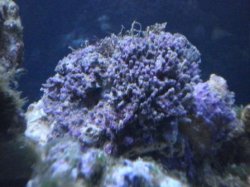Crazy fishes
Fish Addict
- Joined
- Jan 21, 2008
- Messages
- 873
- Reaction score
- 0
I have bought my first corals today; I got some green star polyp and Zoa which I believe is of the Palythoa genus. The pics attached will help you decide, which when you have can you tell me if they are Palythoa or Zoanthids. The green star has refused to open at all since being tranferred into my tank and the zoa has opened partially to fully. Should I be worried about the green star polyps; I'm not sure what to do next other than wait. Is there anything to do?
Before I purchased them I checked the water chemistry once more, these are the findings: Temp=26C, S.G=1.024, pH=8.4, Kh=18, NH3/NH4=0, NO2=0 NO3=10, PO4=0, Ca= 400. It is all good with the exception of Kh which is too high, but that is falling rapidly.
Regards
Before I purchased them I checked the water chemistry once more, these are the findings: Temp=26C, S.G=1.024, pH=8.4, Kh=18, NH3/NH4=0, NO2=0 NO3=10, PO4=0, Ca= 400. It is all good with the exception of Kh which is too high, but that is falling rapidly.
Regards





 . I got some calcium suppliments today with added magnesium and strontium (Seachem Raise calcium). Started to dose the tank with that and put it in sync with the carbonate buffer. The skunk cleaner shrimp absolutely adores the Zoa and is climbing all over it. The polyps are trying to open but are forced to close when the shrimp trends on them, is this a problem? I would imagine that it is fine but just want to check since things which I think are fine turn out to be bad.
. I got some calcium suppliments today with added magnesium and strontium (Seachem Raise calcium). Started to dose the tank with that and put it in sync with the carbonate buffer. The skunk cleaner shrimp absolutely adores the Zoa and is climbing all over it. The polyps are trying to open but are forced to close when the shrimp trends on them, is this a problem? I would imagine that it is fine but just want to check since things which I think are fine turn out to be bad.